Family name: Stemonaceae Caruel
Synonym(s): Croomiaceae Nakai; Pentastemonaceae Duyfjes; Roxburghiaceae Wall.
Common name(s): stemona family
*Number of genera/species: 4/37
List of genera records in GRIN-Global
fruit or seed
Fruit a septicidalsepticidal:
type of capsular dehiscence, opening longitudinally by separating between the septa of adjacent carpels
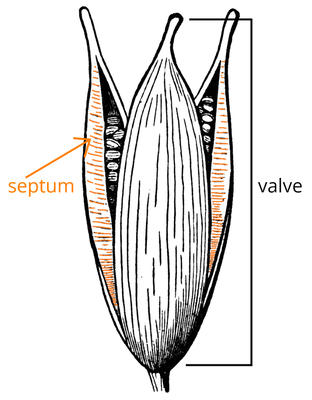 capsulecapsule:
capsulecapsule:
a dry, dehiscent fruit derived from a compound ovary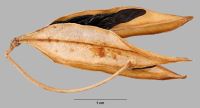 (2-valved) or berryberry:
(2-valved) or berryberry:
an indehiscent, fleshy fruit with one or a few to many seeds. The flesh may be homogenous throughout. Or, if the outer part is hard, firm, or leathery, referred to as an hesperidium. Septa are present in some, and the seeds may be arillate or with a fleshy testa. (Pentastemona), 7–70 mm long, globoseglobose:
(Pentastemona), 7–70 mm long, globoseglobose:
3D shape—more or less spherical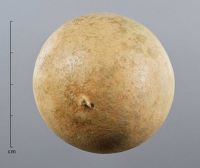 , ovoidovoid:
, ovoidovoid:
3D shape—ovate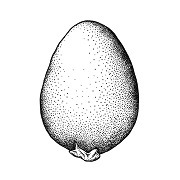 , or oblongoblong:
, or oblongoblong:
2D shape—much longer than broad with nearly parallel sides, corners are rounded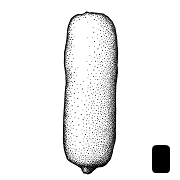 , tereteterete:
, tereteterete:
approximately circular in cross section; width and thickness approximately equal
 or compressedcompressed:
or compressedcompressed:
flattened; in grasses, used to denote compression (not necessarily flattened) either laterally or dorsiventrally
in transection, sometimes beakedbeak:
a usually firm, terminal appendage, sometimes tapered or winged, with one to many seeds. Pericarppericarp:
or winged, with one to many seeds. Pericarppericarp:
fruit wall or fruit coat
green, membranousmembranous:
texture—extremely thin, pliable, and fairly tough
, sharply ridgedridged:
surface relief—raised, thick ridges, sharp edged or rounded, usually in a series that may cover the entire surface in Pentastemona (10 laterallateral:
in Pentastemona (10 laterallateral:
(of embryo) embryo lies along the side of the seed, generally towards one end; of, at, or from the side; in grasses, can refer to the sides adjacent to the dorsal and ventral sides
ridges or ribs). One to few seeds apically attached in Croomia and Stichoneuron. One to ten seeds basally attached in Stemona and with long funiculifuniculus:
(alt. funicle) stalk connecting the ovule (later seed) to the ovary (later fruit) placenta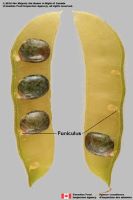 . FuniculiFuniculus:
. FuniculiFuniculus:
(alt. funicle) stalk connecting the ovule (later seed) to the ovary (later fruit) placenta short in all other genera.
short in all other genera.
Seeds globoseglobose:
3D shape—more or less spherical to mitaformmitaform:
to mitaformmitaform:
shaped like a child's mitten
, 1–20 mm long, tereteterete:
approximately circular in cross section; width and thickness approximately equal
 in transection, elaiosomeselaiosome:
in transection, elaiosomeselaiosome:
a lipid and protein-rich fleshy structure attached to some seeds and fruits, it attracts ants which then disperse the disseminule (e.g., caruncle in the Euphorbiaceae, the aril (outgrowth of the funiculus) in the Fabaceae) present and variable on or near funicli. Seed coat shinyshiny:
present and variable on or near funicli. Seed coat shinyshiny:
uniformly reflecting a high proportion of incident light at all angles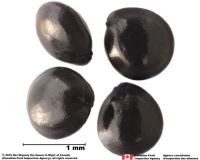 , leatheryleathery:
, leatheryleathery:
texture—moderately thick, tough, and very pliable
, thick or thin, reticulatereticulate:
surface relief—netted, raised walls or concave grooves forming a net-like surface pattern with flat, concave, or convex interspaces , ribbedribbed:
, ribbedribbed:
surface relief—wide, prominent, linear ridges that are generally rounded and longitudinally situated on the surface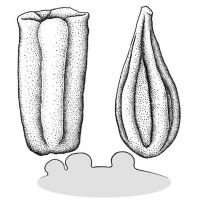 , ridgedridged:
, ridgedridged:
surface relief—raised, thick ridges, sharp edged or rounded, usually in a series that may cover the entire surface , or groovedgrooved:
, or groovedgrooved:
surface relief—linear depressions that may be single or form a series of grooves over the surface . In Pentastemona, collarlike elaiosomeselaiosome:
. In Pentastemona, collarlike elaiosomeselaiosome:
a lipid and protein-rich fleshy structure attached to some seeds and fruits, it attracts ants which then disperse the disseminule (e.g., caruncle in the Euphorbiaceae, the aril (outgrowth of the funiculus) in the Fabaceae) cover about 1/3 of the seeds, and transparent sarcotestassarcotesta:
cover about 1/3 of the seeds, and transparent sarcotestassarcotesta:
pulpy or fleshy outer layer of the seed coat, simulates aril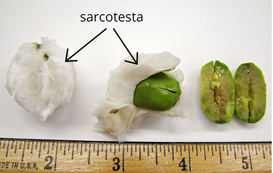 are also present, which is visible even in dry seeds. The elaiosomeselaiosome:
are also present, which is visible even in dry seeds. The elaiosomeselaiosome:
a lipid and protein-rich fleshy structure attached to some seeds and fruits, it attracts ants which then disperse the disseminule (e.g., caruncle in the Euphorbiaceae, the aril (outgrowth of the funiculus) in the Fabaceae) in Croomia and Stichoneuron are composed of uniseriate hairs, which are flimsy in Stichonueron. In Stemona, elaiosomeselaiosome:
in Croomia and Stichoneuron are composed of uniseriate hairs, which are flimsy in Stichonueron. In Stemona, elaiosomeselaiosome:
a lipid and protein-rich fleshy structure attached to some seeds and fruits, it attracts ants which then disperse the disseminule (e.g., caruncle in the Euphorbiaceae, the aril (outgrowth of the funiculus) in the Fabaceae) are lobed and of vesicular hairs.
are lobed and of vesicular hairs.
Embryo small, well developed, linearlinear:
(shape) long, narrow, and uniform in width; (of embryo) embryo is straight and much longer than wide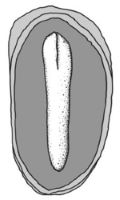 , straight or minute, rudimentaryrudimentary:
, straight or minute, rudimentaryrudimentary:
(of embryo) embryo is small and fills less than a quarter of the seed and can be variable in shapes, such as linear, spatulate, or oval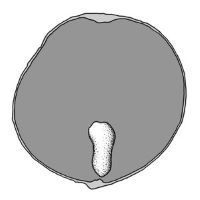 (Pentastemona).
(Pentastemona).
Endosperm copious, fleshy or hard, smooth.
| Fruit | |
| Type | capsulecapsule: a dry, dehiscent fruit derived from a compound ovary  , berryberry: , berryberry:an indehiscent, fleshy fruit with one or a few to many seeds. The flesh may be homogenous throughout. Or, if the outer part is hard, firm, or leathery, referred to as an hesperidium. Septa are present in some, and the seeds may be arillate or with a fleshy testa.  |
| Size range | 7–70 mm long |
| Shape(s) | globoseglobose: 3D shape—more or less spherical  , ovoidovoid: , ovoidovoid:3D shape—ovate  , oblongoblong: , oblongoblong:2D shape—much longer than broad with nearly parallel sides, corners are rounded  |
| Texture | membranousmembranous: texture—extremely thin, pliable, and fairly tough |
| Surface relief | sharply ridgedridged: surface relief—raised, thick ridges, sharp edged or rounded, usually in a series that may cover the entire surface  in one genus in one genus |
| Color(s) | green |
| Unique features | Green capsulescapsule: a dry, dehiscent fruit derived from a compound ovary  or berriesberry: or berriesberry:an indehiscent, fleshy fruit with one or a few to many seeds. The flesh may be homogenous throughout. Or, if the outer part is hard, firm, or leathery, referred to as an hesperidium. Septa are present in some, and the seeds may be arillate or with a fleshy testa.  bearing ornamented seeds with elaiosomeselaiosome: bearing ornamented seeds with elaiosomeselaiosome:a lipid and protein-rich fleshy structure attached to some seeds and fruits, it attracts ants which then disperse the disseminule (e.g., caruncle in the Euphorbiaceae, the aril (outgrowth of the funiculus) in the Fabaceae)  . . |
| Seed | |
| Size range | 1–20 mm long |
| Shape(s) | mitaformmitaform: shaped like a child's mitten , oblongoblong: 2D shape—much longer than broad with nearly parallel sides, corners are rounded  , ovoidovoid: , ovoidovoid:3D shape—ovate  , ellipsoidellipsoid: , ellipsoidellipsoid:3D shape—elliptic , globoseglobose: 3D shape—more or less spherical  |
| Surface relief | reticulatereticulate: surface relief—netted, raised walls or concave grooves forming a net-like surface pattern with flat, concave, or convex interspaces  , ribbedribbed: , ribbedribbed:surface relief—wide, prominent, linear ridges that are generally rounded and longitudinally situated on the surface  , ridgedridged: , ridgedridged:surface relief—raised, thick ridges, sharp edged or rounded, usually in a series that may cover the entire surface  , groovedgrooved: , groovedgrooved:surface relief—linear depressions that may be single or form a series of grooves over the surface  |
| Unique features | Shinyshiny: uniformly reflecting a high proportion of incident light at all angles  , ornamented seeds with leatheryleathery: , ornamented seeds with leatheryleathery:texture—moderately thick, tough, and very pliable seed coats and elaiosomeselaiosome: a lipid and protein-rich fleshy structure attached to some seeds and fruits, it attracts ants which then disperse the disseminule (e.g., caruncle in the Euphorbiaceae, the aril (outgrowth of the funiculus) in the Fabaceae)  . . |
| Other | |
| Embryo | small, well developed, linearlinear: (shape) long, narrow, and uniform in width; (of embryo) embryo is straight and much longer than wide  , straight or minute, rudimentaryrudimentary: , straight or minute, rudimentaryrudimentary:(of embryo) embryo is small and fills less than a quarter of the seed and can be variable in shapes, such as linear, spatulate, or oval  (Pentastemona) (Pentastemona) |
| Nutritive tissue | endosperm copious, fleshy or hard, smooth |
India, southern China, Japan to Australia, and southeast USA.

Distribution map courtesy of Angiosperm Phylogeny Website.
Baskin and Baskin 2021Baskin and Baskin 2021:
Baskin C and Baskin J. 2021. Relationship of the lateral embryo (in grasses) to other monocot embryos: A status up-grade. Seed Science Research 31 (3): 199-210. doi:10.1017/S0960258521000209; Dahlgren et al. 1985Dahlgren et al. 1985:
Dahlgren RMT, Clifford HT, and Yeo PF. 1985. The families of the monocotyledons: structure, evolution, and taxonomy. Springer-Verlag, Berlin. 520 pp.; Flora of Australia 2021+Flora of Australia 2021+:
Flora of Australia. Australian Biological Resources Study, Canberra. Accessed January 2021–March 2024. URL: http://www.ausflora.org.au; Flora of North America Editorial Committee 1993+Flora of North America Editorial Committee 1993+:
Flora of North America Editorial Committee, eds. 1993+. Flora of North America North of Mexico [Online]. 22+ vols. Flora of North America Association, New York and Oxford. Accessed January-March 2024. URL: http://beta.floranorthamerica.org.; Kirkbride et al. 2006Kirkbride et al. 2006:
Kirkbride JH, Jr, Gunn CR, and Dallwitz MJ. 2006. Family guide for fruits and seeds, vers. 1.0. Accessed September 2020-January 2022. URL: https://nt.ars-grin.gov/seedsfruits/keys/frsdfam/index.cfm .; Kubitzki et al. 1990+Kubitzki et al. 1990+:
Kubitzki K et al., eds. 1990+. The families and genera of vascular plants. 7+ vols. Berlin etc.; Nooteboom et al. 2021+Nooteboom et al. 2021+:
Nooteboom HP, de Wilde WJJO, Stevens PF, Coode MJE, and Saw LG. 2021+ Flora Malesiana Online. Accessed January 2021–March 2024. URL: https://portal.cybertaxonomy.org/flora-malesiana/; Zhengyi et al. 2004+Zhengyi et al. 2004+:
Zhengyi W, Raven PH, and Deyuan H. 2004+. Flora of China [online]. 25 vols. Science Press, Beijing China & Missouri Botanical Garden, St. Louis USA. Accessed January–March 2024. http://flora.huh.harvard.edu/china/
*The number of genera and species is based on Christenhusz and Byng 2016Christenhusz and Byng 2016:
Christenhusz MJM and Byng JW. 2016. The number of known plant species in the world and its annual increase. Phytotaxa 261 (3): 201-217. https://doi.org/10.11646/phytotaxa.261.3.1, which may differ from the number of genera in GRIN-Global.